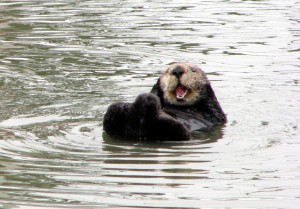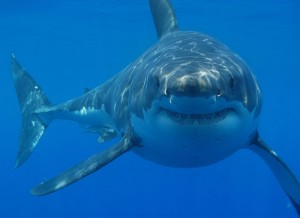This week I was lucky enough to join Kevin Lafferty on his monthly sea otter survey along the coastline north of the University of California Santa Barbara. In addition to surveying the sea otter population, the survey also keeps track of the number of harbor seals, sea lions, dolphins, whales, and various bird species living in or passing through the area. The surveys has been going on for years now and these sorts of datasets are important because they allow us to track how population numbers changes over time and to determine if any particularly factors are associated with changes in population numbers (e.g., how are changes in climate influencing population size?).
 California sea otters are endangered and have had a long streak of bad luck. Their first bad break was when their pelts became popular in the fur trade, resulting in a major collapse in population size due to hunting pressure. Conservation efforts have helped to bolster sea otter numbers, but more recent threats have popped up. More recently sea otters have been suffering from parasites that end up in sea otters “accidentally” (click here for a popular press article on Kevin’s work in this area). For example, sea otters switch to eating crabs when their preferred foods (e.g., sea urchins) aren’t readily available and the otters accidentally acquire acanthocephalan parasites living in the crabs. I use the term “accidentally” because these parasites complete their life cycle in crab-eating birds and so the sea otters represent a dead end for them. Unfortunately, these parasites can still survive in the sea otters and they cause massive intestinal damage, which can result in death. The sea otters are also being parasitized by our old friend Toxoplasma gondii, which apparently makes it into the marine habitat when cat feces end up in water sources which flow out to the ocean.
California sea otters are endangered and have had a long streak of bad luck. Their first bad break was when their pelts became popular in the fur trade, resulting in a major collapse in population size due to hunting pressure. Conservation efforts have helped to bolster sea otter numbers, but more recent threats have popped up. More recently sea otters have been suffering from parasites that end up in sea otters “accidentally” (click here for a popular press article on Kevin’s work in this area). For example, sea otters switch to eating crabs when their preferred foods (e.g., sea urchins) aren’t readily available and the otters accidentally acquire acanthocephalan parasites living in the crabs. I use the term “accidentally” because these parasites complete their life cycle in crab-eating birds and so the sea otters represent a dead end for them. Unfortunately, these parasites can still survive in the sea otters and they cause massive intestinal damage, which can result in death. The sea otters are also being parasitized by our old friend Toxoplasma gondii, which apparently makes it into the marine habitat when cat feces end up in water sources which flow out to the ocean.
More recently, researchers have been finding sea otter bodies washing up on shore with evidence of great white shark bite marks (see here for more information and a video on the topic). There is a larger than usual great white population off the coast of California right now, possibly because we had a really cool summer, resulting in ocean temperatures are within the range favored by great whites. The sharks typically eat sea lions, and the working hypothesis is that they are mistaking the otters for sea lions and are spitting them out when they realize their error. Unfortunately, the otters don’t typically recover from an exploratory great white bite.
So how does this story relate to me (as the title suggests)? Well, I’ll let you in on a little secret. I watched Jaws at a critical period in my development and I’m terrified of sharks. I know it’s ridiculous. I know that there are very few sharks out in the water, that they aren’t particularly interested in making a meal out of humans, and that my chances of encountering one are really low. That doesn’t change the fact that when a piece of kelp brushes against my foot while I’m in the ocean I have to stifle a scream. I realize this is totally irrational behavior for an ecologist.
I heard the sea otter story on NPR right before jumping in the truck with Kevin and Julio to do the survey. After hours on the boat I hadn’t seen any sharks. Also, Kevin and Julio had been in the water and neither of them had been eaten, so I decided to get brave and jump in. Mind you, this was a HUGE step for me.
So, I’m floating around in the water and am feeling quite proud of myself. I had just finished congratulating myself on how calm I was staying when Julio, looking off in the distance, says to me, “Kelly, I think you should get on the boat now.” I immediately decided that this meant Julio had seen a shark, sending me into a panic as I tried to get back onto the boat. After slipping a few times on the ladder, I managed to hurl myself up onto the deck of the boat, as Kevin and Julio looked on in confusion. I should mention, Kevin and Julio do NOT share my fear of sharks and are both inherently cool surfer guys. Here I am, inherently uncool to begin with, sprawled out on the deck of the boat terrified. Turns out Julio thought we were getting too close to another boat and didn’t want to turn the engine on to move the boat while I was in the water (lest the propeller make chum out of me). He couldn’t have imagined that my brain would come up with sharks as the default reason to get out of the water.
Anyway, I’m clearly making a good impression on the Kuris Lab as a visiting researcher.
I’d love to hear stories about how you’ve embarrassed yourself in front of colleagues in the comments.


Hi.
Interesting stuff! And amusing story, too. I’ve got a somewhat embarrassing work story of my own.
Once upon a time, I was a technician at a decent-sized company with roughly one hundred desktop computers in use at any given time. Almost all of these were only upgraded on an as-needed basis, naturally (with the exception of certain critical software or OS modifications, which were handled automatically).
This wasn’t a tech-based company; the workstations had limited (albeit critical) functionality, and the employees who sat at them didn’t know (or need to know) anything about computers in general. Think thick clients, if you know the term. Any given employee couldn’t hazard a guess what a “file browser” or “extension” might be, though they’d easily handle advanced features of our software which would mystify an untrained tech.
These details are important because the sort of environment that comes from scores of employees spreading dirt and debris for years in crannies cleaning crews aren’t allowed to explore is a fine environment for cockroaches and a variety of other pests.
This, in turn, is important because I have a fear of insects and a specific terror of cockroaches. Insects make me nervous, but a cockroach in close proximity can give me panic attacks. An encounter with a live cockroach is one of the most horrifying things I can imagine, and I’m never really convinced that the dead ones are dead, which makes them almost as bad. Just picking up a dead cockroach with a sheet of paper (after ensuring as best I can, with rocks and Raid, that it is indeed dead) will leave me shaking like a leaf; if I inadvertently touch it as I’m disposing of the corpse, I won’t stop shaking for hours.
Fortunately, I worked there six months without encountering anything of the arthropodal persuasion for six months, save some ants that sneaked into and out of the break room, then never came back. (They probably tried the leftovers. Poor ants.)
Unfortunately, six months in, my manager’s desktop computer broke down and I had to come crawl under the desk a bit to do some repairs.
It was some time before I even noticed the creature, and it was probably dead (no cockroach is ever definitely dead), but I didn’t know that. Not having noticed it before, the impression was of a hunched, brownish-black form with beady eyes that had emerged from the shadows to corner me. (Yes, it was behind me. Meaning I moved in front of it. Look, I was focused on the computer–and I’m one of those technicians that ought to be reckoned legally blind to the world when they’re working on something.)
Fortunately, my manager was not there to watch me freeze like a statue (as the fear kicked in), then jump up, flip out–I may have screamed, I couldn’t say–and half-run, half-dive out of the office and to the bathroom, where I must’ve spent twenty minutes trying to refrain from hyperventilating.
Unfortunately, not only does my manager have an open door policy and a nice, big window that let everyone anywhere nearby watch me freak, I passed him on my way out of the office.
So, yeah. Embarrassed myself. Keenly. Over a harmless bug which, upon later examination (it’s not like I was done with the computer yet), was almost certainly dead.
(They’re never, ever definitely dead.)
At least great whites are actually dangerous. Here’s some fun facts.
According to the Florida Museum of Natural History, sharks have, unprovoked, attacked roughly a thousand people in the last three centuries, killing about forty. The number of unprovoked cockroach attacks in that same amount of time is currently believed to be between zero and one, with no fatalities, depending on the definition of “provoked” and “attack.” The official number was originally one, but the victim of the attack took offense, objecting to the museum staff’s explanation that his reflexes were too embarrassingly slow for his swat at the cockroach to qualify as provocation for its sudden flight toward him. The number dropped to zero when he finally convinced them that the cockroach’s flight did not qualify as an attack since it had apparently died of shame in midair before it could take any indisputably aggressive actions.
In 2008, it was confirmed that a particularly large great white shark could technically be capable of biting with up to 18,000 Newtons of force. While it is confirmed that cockroaches can bite, their bite force is yet to be measured. Researchers are hopeful that a particularly large cockroach, albeit not an American or German cockroach (the more common species), will eventually be proven to be technically capable of biting with up to 1 Newton of force. The project has been frozen due to difficulties finding a compound which will be desirable enough that the cockroaches will bite, but not so desirable that the research assistants will bite. Given the nature of the research, however, it’s becoming increasingly apparent that these lab researchers will bite at anything–the cockroaches are just too choosy.
Just found the blog; loving it.
-Chris T
–
References (it seemed polite):
Florida Museum of Natural History, Confirmed Unprovoked Shark Attacks: http://www.flmnh.ufl.edu/fish/sharks/statistics/GAttack/mapusa.htm
Wroe, S., Huber, D. R., Lowry, M., McHenry, C., Moreno, K., Clausen, P., Ferrara, T. L., Cunningham, E., Dean, M. N. and Summers, A. P. (2008), Three-dimensional computer analysis of white shark jaw mechanics: how hard can a great white bite?. Journal of Zoology, 276: 336–342. doi: 10.1111/j.1469-7998.2008.00494.x
Thanks for sharing your story!!!
I’m also not a big fan of cockroaches (to put it lightly). In parasitology lab we had to pick a live cockroach out of a plastic tub, kill it ourselves, and then dissect it. I consider myself relatively tough an I told myself I wouldn’t scream when I picked it up, but my inner wimp won and I screamed like a girl. I eventually settled down, but those things are just creepy!
Helpful blog, bookmarked the website with hopes to read more!